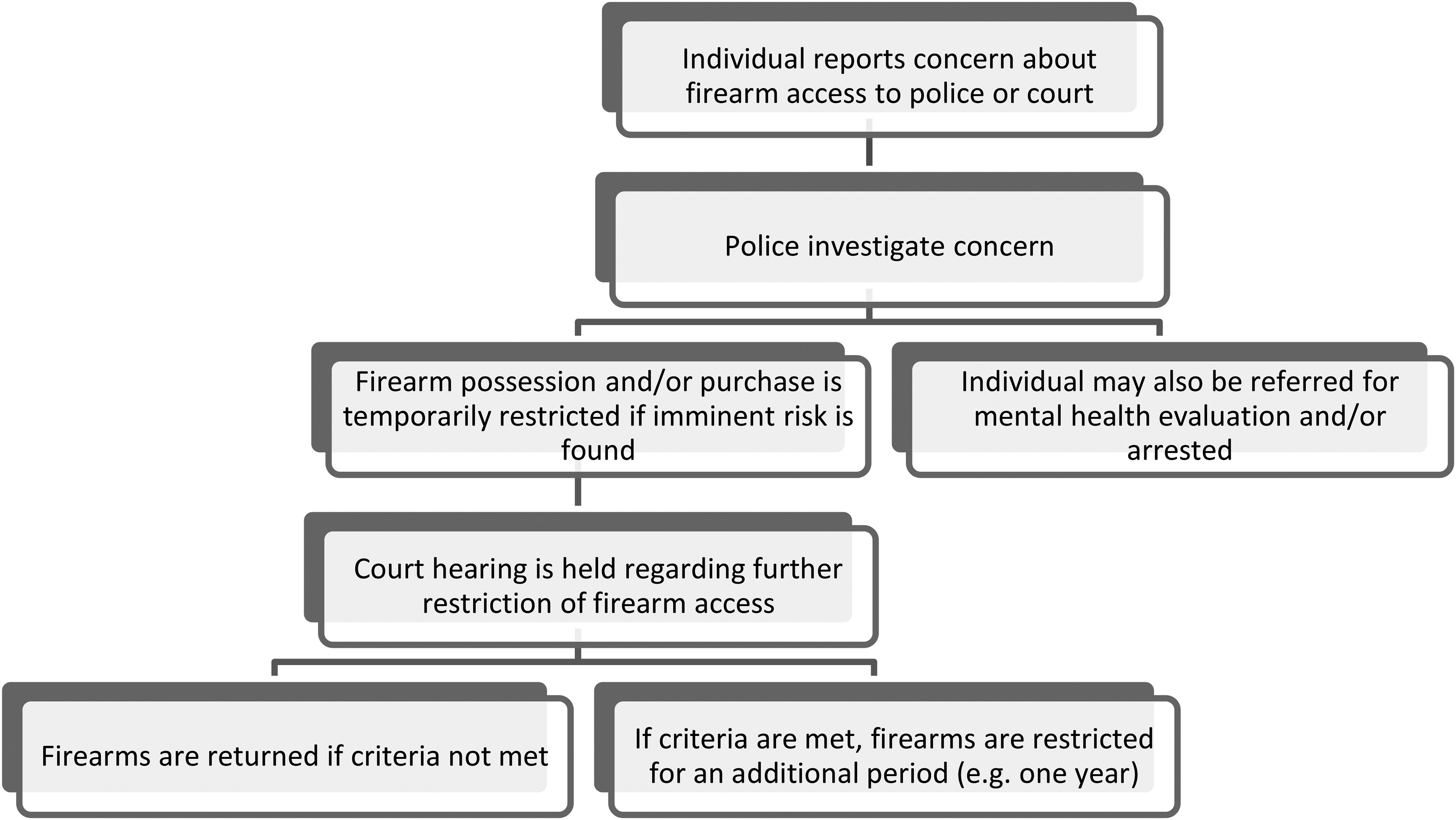Resource Document on Risk-Based Gun Removal Laws
Introduction
How Do Risk-Based Gun Removal Laws Work?

Outcomes Data
How Often are Risk-Based Gun Removal Laws Used?
Who Typically Initiates the Firearm Removal Process?
Whose Firearms are Removed?
Under What Circumstances are Firearms Removed?
What Happens to Firearms After They are Removed?
What Happens to the Individual After His or Her Firearms are Removed?
How Long is Firearm Access Restricted?
Key Findings from Studies of Risk-Based Gun Removal Laws
Advantages and Limitations of Risk-Based Gun Removal
Guidance for Mental Health Professionals
Footnotes
References
Appendix A: Selected State Statutes Regarding Preemptive Firearm Removal from Persons at Risk of Violence Towards Self or Others (Prepared by Kelly Roskam, J.D., Consortium for Risk-Based Firearm Policies]
| Connecticut | Indiana | ||
|---|---|---|---|
| Type of process | Warrant | Warrant | Warrant-less |
| Who initiates the process? | • Two law enforcement officers, or • A state’s attorney, or • An assistant state’s attorney. | Law enforcement officer. | Law enforcement officer. |
| What must be proven? | The entity seeking the warrant must show probable cause to believe that a person poses a risk of imminent injury to himself, herself, or another, such person possesses one or more firearms, and such firearm(s) are within or upon any place, thing or person. | The law enforcement officer must show probable cause exists to believe that the individual is dangerous and in possession of a firearm. | |
| Factors considered in deciding whether the burden has been met | To issue a warrant, judges shall consider: • Recent threats or acts of violence directed toward himself, herself or another, and • Recent acts of cruelty to animals. • The reckless use, display, or brandishing of a firearm, • A history of the use, attempted use, or threatened use of physical force by such person against another, • Prior involuntary confinement of such person in a hospital for persons with psychiatric disabilities, and • The illegal use of controlled substances or abuse of alcohol. | No factors are specified. | No factors are specified. |
| Court Review/Approval | Court approval is required prior to the removal of firearms. | Court approval is required prior to the removal of firearms. | Court approval is not required prior to the removal of firearms. |
| Length of prohibition on purchase/possession of firearms and removal of firearms | Removal of firearms pursuant to the warrant lasts up to 14 days until a hearing can be held. | The removal of firearms lasts up to 14 days from the return of an executed warrant. | The removal of firearms lasts up to 14 days after written submission to the court justifying the warrant-less removal. |
| How are firearms removed? | Law enforcement shall execute the warrant to search for and seize firearms. | Law enforcement shall execute the warrant to search for and seize firearms. | Law enforcement shall seize the firearms. |
| Is a hearing automatically scheduled to provide an opportunity to challenge it, and if so, when is it held? | Yes, a hearing shall be held within 14 days of the issuance of a warrant. | Yes, a hearing shall be held within 14 days of the return of an executed warrant. | Yes, a hearing shall be held within 14 days of a written submission.1 |
| What must be proven at the hearing? | The state must prove by clear and convincing evidence that the owner remains “a risk of imminent injury to self or others.” | The state must prove by clear and convincing evidence that the respondent is dangerous. | |
| Length of prohibition on purchase/possession of firearms and removal of firearms | Up to one year after the hearing. | 180 days after the hearing, at which point the respondent may petition for return. | |
| Statute(s) | Conn. Gen. Stat. Ann. § 29-38c. | Ind. Code Ann. § 35-47-14. | |
| California | |||
|---|---|---|---|
| Type of process | A civil court order called the Gun Violence Restraining Order (“GVRO”). | ||
| Type of GVROs | Temporary Emergency GVRO | Ex Parte GVRO | Final GVRO |
| Who initiates the process? | Law enforcement only. | Law enforcement or an immediate family member. | Law enforcement or an immediate family member. |
| What must be proven? | The petitioner must show reasonable cause to believe (1) the subject of the petition poses an immediate and present danger of causing personal injury to himself, herself, or another AND (2) less restrictive alternatives have been ineffective, or are inappropriate or inadequate for the situation. | The petitioner must show a substantial likelihood (1) the subject of the petition poses a significant danger, in the near future, of personal injury to himself, herself, or another AND (2) less restrictive alternatives have been ineffective, or are inappropriate or inadequate for the situation. | The petitioner must prove by clear and convincing evidence (1) the subject of the petition, or person subject to an ex parte GVRO, poses a significant danger of personal injury to himself, herself, or another AND (2) less restrictive alternatives have been ineffective, or are inappropriate or inadequate for the situation. |
| Factors considered in deciding whether the burden has been met | No factors specified. | The court shall consider the following factors: • A recent threat or act of violence directed toward himself, herself, or another, • A violation of an emergency protective order, • A recent violation of an unexpired protective order, • A conviction for an enumerated violent offense, • A pattern of violent acts or violent threats within the past 12 months. Judges may consider any other relevant evidence, including, but not limited to: • The unlawful, reckless use, display, or brandishing of a firearm, • The history of use, attempted use, or threatened use of physical force, • Any prior arrest for a felony offense, • Any history of a violation of a protective order, • Evidence of alcohol or controlled substance abuse, • Recent acquisition of firearms, ammunition, or other deadly weapons. | |
| Court Review/Approval | Court review or approval is required prior to the prohibition on purchase/possession and removal of firearms taking effect. | ||
| Length of prohibition on possession of firearms | 21 days. | 21 days or less (until hearing). | One year. |
| How are firearms removed? | Upon request of a law enforcement officer serving a GVRO, firearms and ammunition shall be surrendered immediately to the control of the officer. If no request is made by the law enforcement officer, the respondent shall surrender all firearms and ammunition, within 24 hours, to the control of the local law enforcement agency, to a licensed firearms dealer, or by selling such firearms and ammunition to a licensed firearms dealer. Law enforcement may seek a warrant to search for and seize firearms and ammunition unlawfully possessed by the subject of a GVRO. | ||
| Is a hearing automatically scheduled to provide an opportunity to challenge it, and if so, when is it held? | No. | Yes, within 21 days of the issuance of an ex parte GVRO. | No (the hearing is held before the issuance of a final GVRO). |
| Statute(s) | Cal. Penal Code § 18100 et seq. | ||
| Washington | ||
|---|---|---|
| Type of process | A civil court order called the Extreme Risk Protection Order (“ERPO”). | |
| Type of ERPOs | Ex Parte ERPO | Final ERPO |
| Who initiates the process? | A law enforcement officer, law enforcement agency, or family or household member. | A law enforcement officer, law enforcement agency, or family or household member. |
| What must be proven? | Petitioners must show a reasonable cause to believe that the respondent poses a significant danger of causing personal injury to self or others in the near future by having in his or her custody or control, purchasing, possessing, or receiving a firearm. | Petitioners must prove by a preponderance of the evidence that the respondent poses a significant danger of causing personal injury to self or others by having in his or her custody or control, purchasing, possessing, or receiving a firearm. |
| Factors considered in deciding whether the burden has been met | Court may consider any relevant evidence, including, but not limited to the following: • Recent act or threat of violence by the respondent against self or others, • A pattern of acts or threats of violence by the respondent within the past 12 months, • Any “dangerous mental health issues, • A violation by the respondent of a protection order or no-contact order, • A previous or existing ERPO issued against the respondent; • A violation of a previous or existing ERPO issued against the respondent; • A conviction of the respondent for a crime of domestic violence; • Ownership, access to, or intent to possess firearms; • Unlawful or reckless use, display, or brandishing of a firearm by the respondent; • History of use, attempted use, or threatened use of physical force by the respondent against another person; • History of stalking another person; • Any prior arrest of the respondent for a felony offense or violent crime; • Corroborated evidence of the abuse of controlled substances or alcohol by the respondent; and • Evidence of the recent acquisition of firearms by the respondent. | |
| Court Review/Approval | Court review or approval is required prior to the prohibition on purchase/possession and removal of firearms taking effect. | |
| Length of prohibition on possession of firearms | 14 days or less (until hearing). | One year. |
| How are firearms removed? | A law enforcement officer serving any ERPO shall request that the respondent immediately surrender all firearms in his or her custody, control, or possession and any concealed pistol license issued to the respondent. The law enforcement officer shall take possession of all respondent’s firearms that are surrendered, in plain sight, or discovered pursuant to a lawful search. If personal service by a law enforcement officer is no possible, or not necessary because the respondent was present at the ERPO hearing, the respondent shall surrender the firearms in a safe manner to the control of the local law enforcement agency within 48 hours of being served with the order by alternate service or within 48 hours of the hearing at which the respondent was present. Where the respondent fails to surrender firearms or a CPL, law enforcement may seek a search warrant. | |
| Is a hearing automatically scheduled to provide an opportunity to challenge it, and if so, when is it held? | Yes, a hearing shall be held within 14 days of the issuance of an ex parte ERPO. | No (the hearing is held before the issuance of a final ERPO). |
| Statute(s) | Wash. Rev. Code Ann. § 7.94.010 et seq. | |
Information & Authors
Information
Published In
History
Authors
Metrics & Citations
Metrics
Citations
Export Citations
If you have the appropriate software installed, you can download article citation data to the citation manager of your choice. Simply select your manager software from the list below and click Download.
For more information or tips please see 'Downloading to a citation manager' in the Help menu.
View Options
View options
PDF/EPUB
View PDF/EPUBLogin options
Already a subscriber? Access your subscription through your login credentials or your institution for full access to this article.
Personal login Institutional Login Open Athens loginNot a subscriber?
PsychiatryOnline subscription options offer access to the DSM-5-TR® library, books, journals, CME, and patient resources. This all-in-one virtual library provides psychiatrists and mental health professionals with key resources for diagnosis, treatment, research, and professional development.
Need more help? PsychiatryOnline Customer Service may be reached by emailing [email protected] or by calling 800-368-5777 (in the U.S.) or 703-907-7322 (outside the U.S.).

